

Enterprise service bus. Un article de Wikipédia, l'encyclopédie libre.
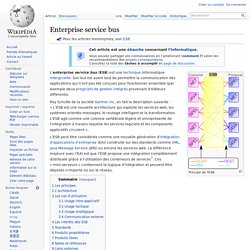
Pour les articles homonymes, voir ESB. L'enterprise service bus (ESB) est une technique informatique intergicielle. Son but est avant tout de permettre la communication des applications qui n'ont pas été conçues pour fonctionner ensemble (par exemple deux progiciels de gestion intégrés provenant d'éditeurs différents). Roy Schulte de la société Gartner inc, en fait la description suivante : « L'ESB est une nouvelle architecture qui exploite les services web, les systèmes orientés messages, le routage intelligent et la transformation.
L'ESB agit comme une colonne vertébrale légère et omniprésente de l'intégration à travers laquelle les services logiciels et les composants applicatifs circulent ». L'ESB peut être considérée comme une nouvelle génération d'intégration d'applications d'entreprise (EAI) construite sur des standards comme XML, Java Message Service (JMS) ou encore les services web. Les principes[modifier | modifier le code] Terminology - Difference Between ESB and EAI. Difference between SOA, EAI and ESB. Difference between SOA, EAI and ESB This was second time when I got into a debate with some senior architects in Bank about the core differences in SOA, EAI and ESB (First one was really drastic in San Francisco over dinner when I was half drunk with more than a couple of litres of beer) Now with no beer today, let me see if I can try to point some good difference between EAI & ESB and perhaps SOA as all this is closely tied together while explaining how they are linked to each other too.

SOA (Service Oriented Architecture) is an approach is to have software resources available (& discoverable) on network as independent services and these services should achieve a business objective. Like this: Like Loading... About manojpurohit Technical Evangelist & Chief Solution Architect - FSI. The difference between EAI and an ESB. What's the difference between an ESB and EAI technology?
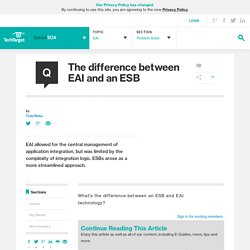
By submitting your personal information, you agree to receive emails regarding relevant products and special offers from TechTarget and its partners. You also agree that your personal information may be transferred and processed in the United States, and that you have read and agree to the Terms of Use and the Privacy Policy. Based on some feedback after my last article regarding using an ESB successfully, as well as reviewing a debate entitled "To ESB or not ESB ... that is the question" on the LinkedIn SOA Special Interest Group, I thought it would be useful to discuss ESB and EAI technology. EAI, or enterprise application integration, technology was around long before the term ESB was coined. These technologies were intended to provide a means for managing the point-to-point integration sprawl that was occurring as connections between disparate systems were becoming increasingly important. My advice is two-fold:
Understanding Enterprise Application Integration - The Benefits of ESB for EAI. In today's enterprise infrastructure, system and application integration is more and more frequently a mission critical concern.
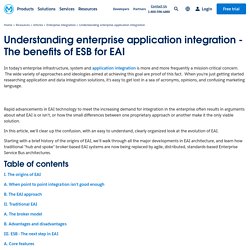
The wide variety of approaches and ideologies aimed at achieving this goal are proof of this fact. When you're just getting started researching application and data integration solutions, it's easy to get lost in a sea of acronyms, opinions, and confusing marketing language. Rapid advancements in EAI technology to meet the increasing demand for integration in the enterprise often results in arguments about what EAI is or isn't, or how the small differences between one proprietary approach or another make it the only viable solution.
In this article, we'll clear up the confusion, with an easy to understand, clearly organized look at the evolution of EAI. Table of Contents I. A. B. II. A. B. III. A. B. C. I. Difference Between ESB and EAI. ESB vs EAI ESB (Enterprise Service Bus) is a piece of infrastructure software that provides a software architecture construct for providing basic services for complex architectures.
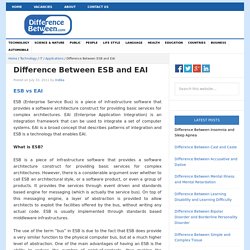
Enterprise%20Integration%20-%20SOA%20vs%20EAI%20vs%20ESB.pdf. Enterprise Knowledge Infrastructures. As often in the industry, buzzwords are created to better sell a product, although it is not fundamentally different from earlier products.
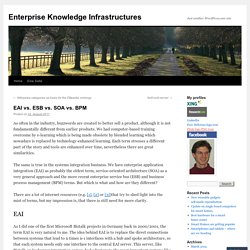
We had computer-based training overcome by e-learning which is being made obsolete by blended learning which nowadays is replaced by technology-enhanced learning. Each term stresses a different part of the story and tools are enhanced over time, nevertheless there are great similarities. The same is true in the systems integration business. We have enterprise application integration (EAI) as probably the oldest term, service-oriented architecture (SOA) as a very general approach and the more recent enterprise service bus (ESB) and business process management (BPM) terms. But which is what and how are they different? As I did one of the first Microsoft Biztalk projects in Germany back in 2000/2001, the term EAI is very natural to me. The flexible orchestration of Web services is often called business process management. So far for the easy part.